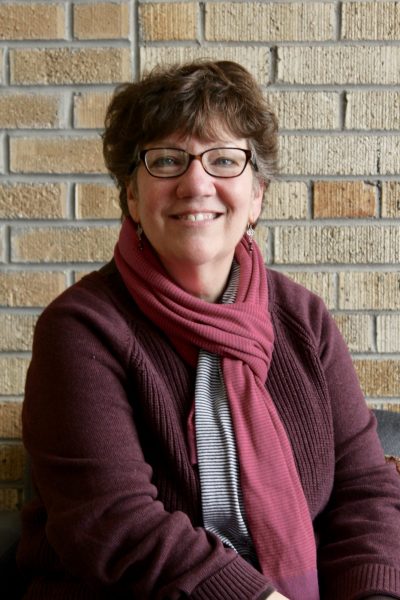Story and photos by Katie Simota

As a child, Kimberly Nichols’ favorite place to visit was the San Francisco Zoo.
“When Mom wanted us out of the house, she would give us a dime and say: ‘Go to the zoo,’” Nichols said. At the zoo, she became friends with a 5-foot-3, 375-pound silverback male gorilla named Bwana.
“Every time I would go to the zoo, I’d bring my sketchbook and Bwana would walk over to the glass and wait for me,” Nichols said. “Then I’d sit down next to him and draw. It was amusing to him. Gorillas are highly intelligent.”
Nichols grew up reading the Mowgli stories by Rudyard Kipling. “I used to pretend that I was Mowgli living in the forest and understanding the animals,” Nichols said. “It is a natural thing that I ended up in paleontology.”
She is now a biological anthropology instructor and paleontologist in the department of anthropology at CSU.
Nichols currently leads the Paleontology Field School Lab here at CSU but got her academic start studying gorillas at the University of California, Santa Cruz.
Her beginning in academia began when Bwana, the gorilla she spent her childhood afternoons visiting, passed away. She was an undergraduate at Santa Cruz when she was invited to work on his dissection.
“At first, it was upsetting, because I thought of Bwana as my friend. But, at the time, I was studying biological anthropology, so I ended up examining his foot, calf, hand and forearm anatomy.”
Upon examination, Nichols identified that Bwana had arthritis. She attributed Bwana’s joint damage to spending his early childhood in a cement-floor enclosure. She presented her research at a Great Ape Conference in Chicago, and her findings provided support for zoo caregivers to argue for natural substrate enclosures that enhance living conditions for their large-bodied animals.
Nichols’ gorilla research led to her graduate degree at the University of Colorado, Boulder, which led to her career at CSU.
At CSU she shares her love for animals and her dedication to understanding their role in the natural world with her students. She educates students on the importance of understanding relationships and interconnections in nature and uses her paleontology research to teach students about current species loss due to climate change.
“My students are interested in taking care of the planet.They understand that when we lose an organism in the wild, we lose balance in our ecosystem and part of our culture,” she said. “I’d hate to see the day when all of the animals that we love are no longer wild.”
Nichols believes paleontology plays a crucial role in helping people understand the intricacies and fragile balance of the earth’s ecosystems. “Paleontology tells us what’s happened in the past, and gives us a template of what we understand about ourselves. Through my work, I can see what happened to an organism over time and how it may or may not have adapted to environmental change over time.”
Through her research and that of other paleontologists and her students, Nichols notes that current extinction patterns are happening at a quicker than natural rate due to human-caused climate change. There simply isn’t enough time for selection to operate on favorable adaptations to these stressors and, as a result, animal species aren’t able to survive.
“Everyone is so excited about going to Mars. Technically, I think it would be cool,” she said. “But, at the same time, for all of the work that it’s going to take to make Mars habitable, we should be putting in that amount of work to return our planet to its maximum habitability.”
While Nichols faces the looming consequences of climate change every day, her love and appreciation for the natural world and all its living pieces only grows stronger.
“I feel like I’m living my dream right now. I love teaching, working with students, and the opportunity to discuss pressing environmental issues,” Nichols said. “This is my life’s work, and I just want to make the world a better place.”